Raw vegan recipes offer a unique and nourishing approach to food, celebrating fresh, whole ingredients without the need for cooking. I discovered this incredible world of raw cuisine a few years ago when I tried a raw vegan cheesecake at a local farmer’s market. At first, it seemed like a simple combination of nuts, fruits, and a creamy filling. But one bite completely changed my perspective—how could something so simple taste so rich, fresh, and indulgent? That experience opened my eyes to the joys of raw vegan meals and their ability to highlight food in its most natural form.
Raw vegan recipes are more than just a food trend—they provide vibrant flavors, enhance overall health, and foster a deeper connection with nature. These meals energize the body and leave you feeling refreshed, not sluggish. Raw veganism is an exciting culinary journey that invites you to explore a new way of eating.
In this guide, you’ll learn what raw vegan recipes are, the key ingredients that make them shine, the science behind the method, and how to prepare your first raw vegan dish step-by-step. Whether you’re curious about this lifestyle or just want to add variety to your meals, you’re in for a delightful experience.
Table of Contents
Ingredient Spotlight
The Essentials for Your Raw Vegan Kitchen
Crafting raw vegan recipes begins with thoughtful ingredient selection. These ingredients don’t just create delicious meals; they also pack nutritional power.
- Leafy Greens: Kale, spinach, romaine, and Swiss chard form the base of salads, smoothies, and wraps. Vitamins A, C, and K abound in them.sh Fruits: Bananas, berries, mangoes, and avocados bring sweetness, color, and creaminess to your dishes.
- Nuts and Seeds: Cashews, almonds, chia seeds, and flaxseeds serve as thickening agents and protein sources.
- Vegetables: Think zucchini for noodles, carrots for crunch, and cucumbers for hydration.
- Sweeteners: Medjool dates, raw agave, or maple syrup provide natural sweetness without needing refined sugars.
| Ingredient | Key Benefits | Substitutions |
| Kale | High in fiber, vitamin-packed | Spinach or Swiss chard |
| Cashews | Creamy texture for sauces | Macadamias or blanched almonds |
| Medjool Dates | Natural sweetener, energy boost | Raisins or dried figs |
Raw Vegan Recipes: Seasonal and Specialty Ingredients
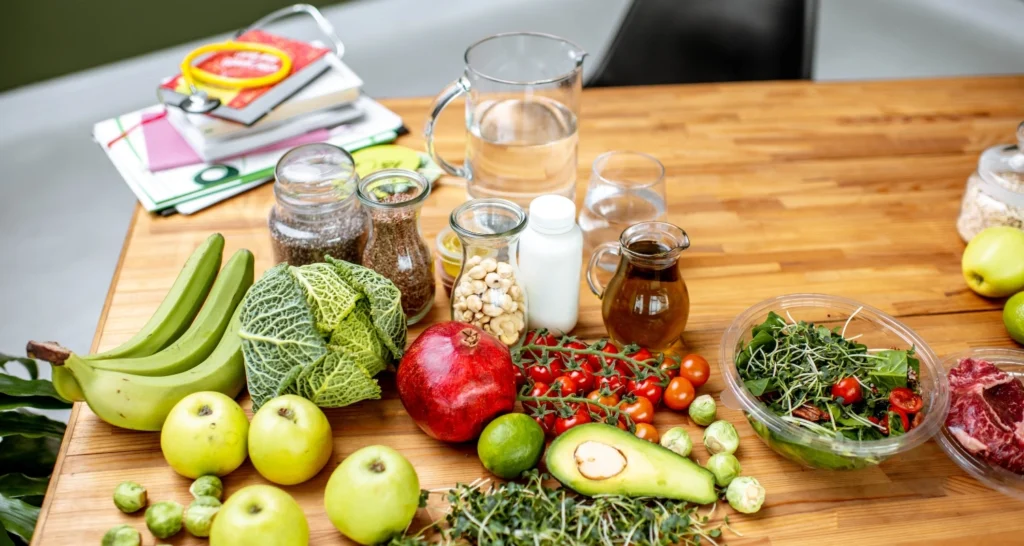
- Coconut Meat: Fresh and tender coconut meat can be used for puddings, sauces, or desserts. Look for it at health food markets or Asian supermarkets.
- Sprouted Grains: Sprouted quinoa and buckwheat are powerhouses of protein and work wonderfully in salads.
- Seasonal Fruits: Using what’s in season enhances freshness. Spring strawberries, summer watermelon, and winter citrus each bring their unique character to dishes.
No access to certain ingredients? No problem. Almost any raw recipe can accommodate substitutions. If fresh mango is not available, frozen chunks can be used just as effectively. Local farmer’s markets are also great places to find unique, fresh options.
The Science Behind Raw Vegan Recipes
What exactly makes raw vegan recipes so special? The answer lies in preserving what nature already perfected—nutrient integrity.
How It Works
When you avoid cooking food beyond 104–118°F, you retain heat-sensitive vitamins, nutrients, and natural enzymes. These enzymes help with digestion, reducing the burden on your body and optimizing nutrient absorption. Raw vegan recipes take full advantage of these benefits, ensuring you’re serving your body the most “alive” form of food.
For example:
- Vitamin C, found in raw bell peppers or citrus fruits, is often destroyed by high heat. By eating raw, you get the full benefit.
- Plant enzymes that aid digestion remain intact, making your meals easier for your body to process.
Culinary Benefits
The raw approach isn’t just about health—it improves flavor and texture in surprising ways too:
- The crunch of raw veggies, the natural sweetness of fruits, and the creamy texture of soaked nuts create layers of taste and satisfaction.
- You’ll also avoid the overly processed textures that cooked or preserved foods can often bring.
Common Myths Debunked
- “Raw food is boring.” On the contrary, raw vegan recipes offer thrilling experimentation with sauces, spices, and global cuisines.
- “You can’t get enough protein.” Between nuts, seeds, and sprouted grains, raw vegans meet protein needs with ease. One cup of sprouted lentils, for example, contains about 7 grams of protein!
- “Raw food is all salads.” Think again! Raw cheesecakes, sushi rolls, and even noodle dishes prove raw cooking is anything but dull.
Step-by-Step Process
Preparation
Before you start, a little prep work goes a long way. You’ll need some essential tools:
- Spiralizer: This gadget turns zucchini into noodles or “zoodles.”
- High-Speed Blender: Ideal for smoothies, sauces, and creamy desserts.
- Food Processor: Great for chopping and mixing ingredients.
- Dehydrator (Optional): For creating crispy crackers, chips, or fruit leathers.
Take the time to pre-soak any nuts or seeds (like cashews or chia) because this step softens them, making blending effortless and enhancing their digestibility. Raw vegan recipes often rely on this technique, as soaked nuts blend into creamier sauces or fillings, perfect for raw cheesecakes or dips.
Raw Vegan Recipe Example: Zucchini Noodles
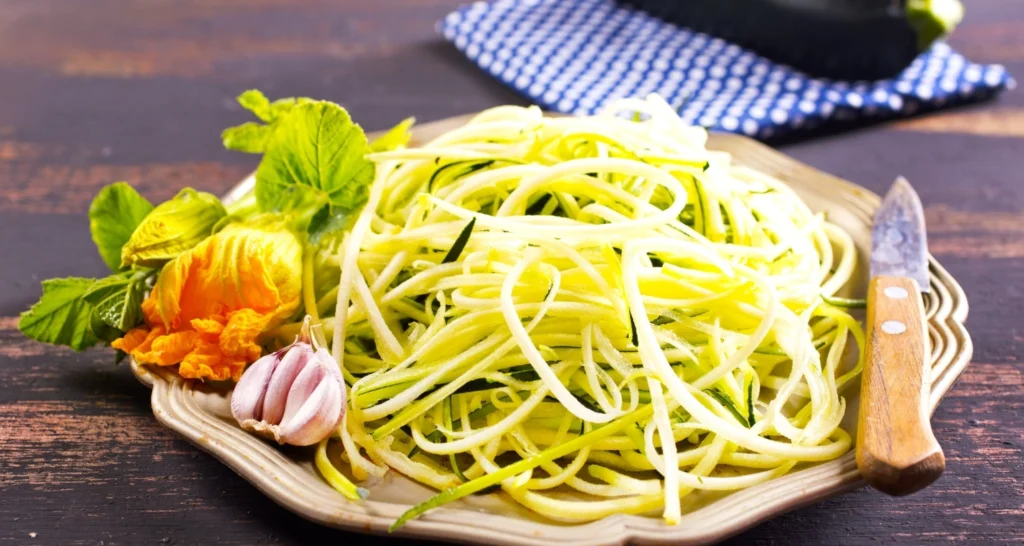
Servings: 2 | Prep Time: 10 minutes
Ingredients:
- Two big zucchini
- One cup of raw cashews, soaked
- ¼ cup lemon juice
- 2 garlic cloves
- 1 tablespoon olive oil
- ½ teaspoon sea salt
- Fresh basil leaves (optional, for garnish)
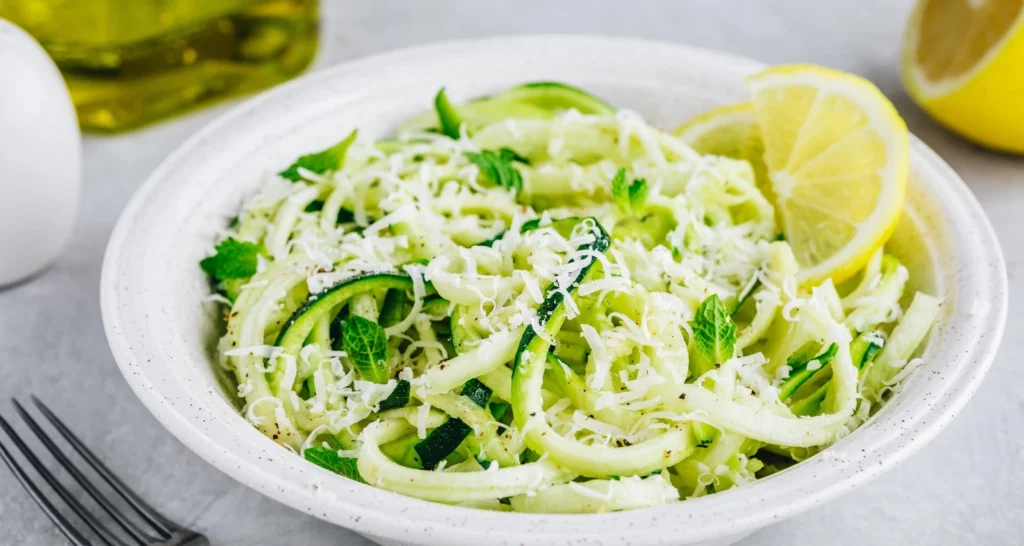
Instructions:
- Prepare Tools: Take your spiralizer and cut the zucchini into long, spaghetti-like noodles. These noodles are a staple in raw vegan recipes. Set the noodles aside in a bowl.
- Make the sauce:
- Add soaked cashews, olive oil, lemon juice, garlic, and salt into a high-speed blender.
- Process on high until creamy and smooth. If needed, add a few tablespoons of water to thin the sauce.
- Mix It Up: Drizzle the cashew sauce over your zucchini noodles. Gently toss to evenly distribute the sauce over them.
- Add chopped fresh basil leaves as a garnish, and for a cheesy touch, sprinkle nutritional yeast on top.
A word of advice: start with a small amount of sauce and add more to taste.
Timing and Temperatures
No ovens or exact timings are needed here! You’ll generally spend 5–15 minutes on raw vegan recipes, with minimal wait time unless soaking nuts or seeds in advance. For the best taste, use ingredients at room temperature—this avoids the shock of cold flavors muting the taste.
Common Mistakes to Avoid
- Overcomplicating Recipes: Keep it Simple. Start with just a few ingredients while you’re learning techniques.
- Skipping the prep work: Not soaking nuts can result in grainy textures rather than smooth creams or sauces.
- Buying Too Much: Freshness is key for raw recipes, so purchase only what you can use in the next few days.
Variations and Customizations
The beauty of raw vegan recipes is how flexible they are. You can customize almost any dish to suit your taste, dietary preferences, or ingredients at hand.
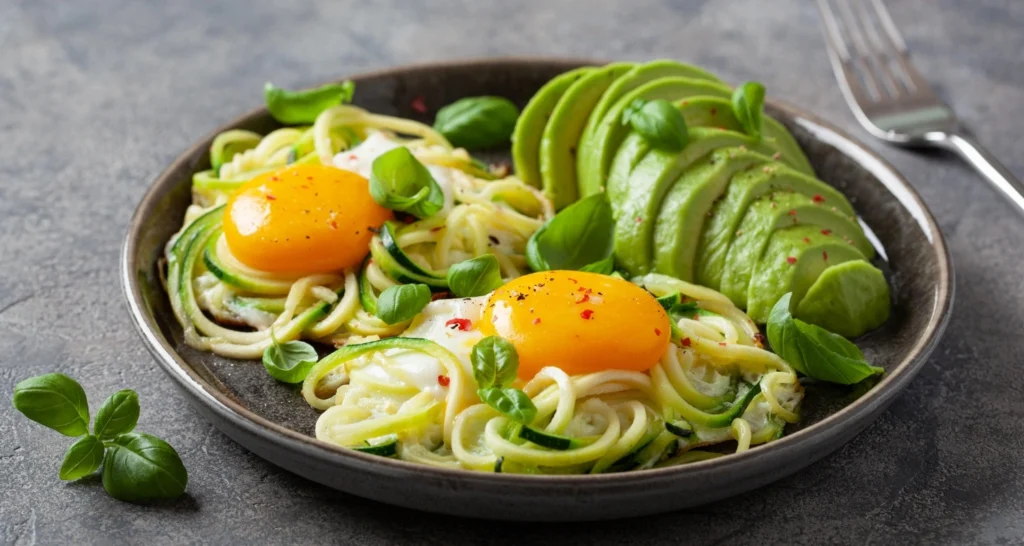
Flavor Variations
- Add Heat Without Cooking: Incorporate spices like cayenne, smoked paprika, or chili flakes to create a lively kick in your dishes.
- Experiment with Fresh Herbs: Basil, mint, dill, and cilantro add unique profiles that can elevate your raw creations.
- Fruity Twists: Add tropical fruits like pineapple or mango to a raw vegan recipe salad for a refreshing balance of sweet and savory.
Regional Twists
Raw recipes often adapt to global cuisines effortlessly.
- Mediterranean-Inspired Raw Vegan Recipes: Use olives, sun-dried tomatoes, and tahini for a raw hummus-inspired dip.
- Asian Fusion: Pair spiralized veggies with a tangy tamari-ginger sauce for raw “stir-fry” noodles.
Tools and Equipment
Having the right tools in your kitchen can mean the difference between frustration and ease when preparing raw vegan meals.
Essential Tools
- High-Speed Blender: Perfect for sauces, soups, and desserts that require smooth textures.
- Food Processor: Ideal for chopping, mixing, and creating dough for raw pies or crackers.
- Spiralizer: Turns vegetables like zucchini or carrots into delightful noodles.
- Dehydrator (Optional): While not necessary for beginners, it’s great for making raw crackers, chips, and bread.
- Sharp Knives: A good, reliable set of knives makes prepping fruits and veggies quicker and safer.
Budget vs. Premium Recommendations
If you’re starting, budget options like entry-level spiralizers or hand blenders work fine. However, investing in a premium blender, such as a Vitamix, provides smoother, more consistent results and lasts longer.
Raw Vegan Recipes Maintenance Tips
- Clean blades and attachments immediately after use, as dried nuts and seeds can be hard to remove.
- Sharpen knives regularly to ensure precision and safety.
- If using a dehydrator, regularly wipe and sanitize trays to prevent buildup.
Meal Prep and Storage
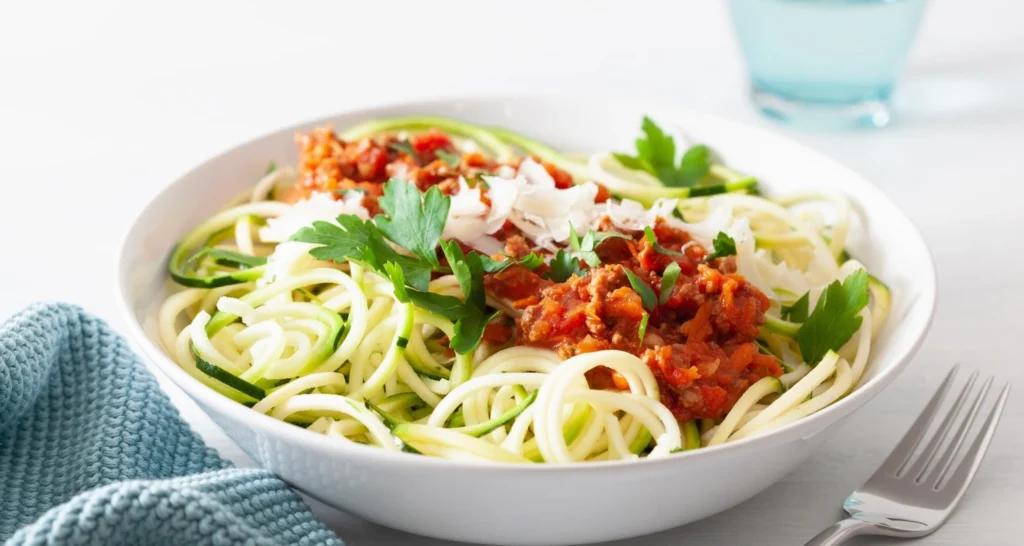
One frequent concern about raw veganism is time management. However, with a little planning, raw vegan recipes become easy to incorporate into your routine.
Make-Ahead Tips
- Pre-Chop Veggies: Store chopped veggies in airtight containers to reduce prep time during the week.
- Batch Sauces for Raw Vegan Recipes: Make large batches of cashew cheese or salad dressings to use across multiple meals.
- Pre-Soak and Freeze Nuts: Once soaked and dried, nuts can be stored in the freezer, ready for blending when needed.
Raw Vegan Recipes: Storage Instructions
- Fridge: Store raw meals in glass containers to maintain freshness. Most raw dishes last 2-3 days in the fridge.
- Freezer: Desserts such as energy balls or raw cheesecakes keep incredibly well in the freezer for up to three months.
Shelf Life
- While staples like dried fruits and seeds can be kept for several months in a cool, dark place, fresh ingredients are best eaten right away.
Raw Vegan Recipes: Serving Suggestions
Presentation and pairing take your raw vegan meals to the next level.
Pairings
- Main Dish Combos: Serve zucchini noodles alongside raw vegan sushi for a complete, balanced meal.
- Dessert Duos: Pair raw cheesecake slices with a refreshing herbal tea or coconut milk latte for a soothing finish.
Presentation Tips
- Arrange dishes with layers and pops of color. A sprinkle of pomegranate seeds or edible flowers can elevate the visual appeal.
- Use high-quality serving utensils and bowls to create an inviting look.
Seasonal Serving Ideas for Raw Vegan Recipes
- Summer Treats: Raw smoothie bowls topped with heaps of fresh berries.
- Holiday Feasts: Raw stuffed mushrooms or hearty nut-based pâtés for a festive touch
Troubleshooting and Error Fixes
Mistakes happen, especially when you’re experimenting with new techniques. Here’s how to avoid (or fix) common errors.
Common Problems with Solutions
- Watery Sauces: Blend in soaked nuts or a pinch of psyllium husk to thicken.
- Over-Spiralized Noodles: Prevent sogginess by salting zucchini noodles lightly and letting them rest before rinsing.
- Bland Flavor: Don’t skimp on herbs, spices, and acid (like lemon juice) to deepen taste profiles.
Quick Fixes
- Too sweet? Add a pinch of salt and more citrus.
- Too tangy? Balance with a drizzle of maple syrup or agave.
FAQ for Common Concerns
Q: Can I prep meals in advance without them losing nutrients?
A: While raw meals are freshest when served immediately, prepping parts of the recipe (like sauces or veggies) preserves nutrients and saves time.
Nutritional and Health Insights
Calories and Macronutrients
Here’s a breakdown of Zucchini Noodles with Cashew Cream Sauce per serving:
- Calories: 230
- Protein: 7g
- Fat: 14g (from healthy fats like cashews and olive oil)
- Carbs: 20g
Health Benefits
- Boosted digestion from enzyme-rich ingredients.
- Healthy fats support brain function and hormone balance.
- High fiber content improves gut health.
Allergy Notes
- Nut allergy? Substitute soaked sunflower seeds for similar creaminess.
- Gluten sensitivity? Almost all raw recipes are naturally gluten-free!
Culinary Fun Facts and History
Origins
Raw veganism dates back to the late 1800s when Dr. Maximilian Bircher-Brenner promoted raw apples for curing ailments. It has since evolved into a modern lifestyle powered by creativity and cultural influence.
Trivia
- Did you know soaking nuts not only improves blending but also reduces natural enzyme inhibitors, making them easier to digest?
- Raw food festivals around the world feature dishes like raw pizzas, tacos, and even burgers!
Cultural Significance
While raw veganism became widely recognized in the West, many indigenous cultures have long celebrated uncooked preparations like ceviche (fish cooked in citrus) and fresh salads using tropical produce.
Raw Vegan Recipes for Holidays and Special Occasions
Seasonal Use
- Think spring salads bursting with pea shoots and radishes or autumn desserts featuring raw spiced pumpkin cheesecake.
Special Occasions
- Impress dinner party guests with a beautifully arranged raw platter featuring seed crackers, dips, and fresh veggies.
- Host a brunch with raw chia pudding parfaits and tropical smoothie bowls.
Festive Variations
For holidays, get creative with festive designs for your raw vegan recipes. For example, shape a raw strawberry cheesecake into a heart for Valentine’s Day or a star for the Fourth of July.
Success Stories and Reader Engagement
Raw veganism isn’t just a diet—it’s a movement. Share your successes or join a community of raw enthusiasts!
Social Media Mentions
Share your creations on Instagram with your take on the recipes using the hashtag #RawVeganCreations. Engage with others for inspiration and feedback.
Interactive Features
- Take a poll on your favorite raw base ingredient (zucchini noodles, anyone?).
- Participate in quizzes like “Which Raw Dessert Matches Your Personality?”
Closing and Call-to-Action
Raw vegan recipes invite you to reconnect with the freshest, most vibrant side of food. Whether you’re jumping in for health reasons, environmental awareness, or sheer curiosity, each bite is a step closer to a more wholesome way of eating.
Now it’s your turn! Share your favorite raw recipe twists, leave a comment below about what you’ll try first, and don’t forget to rate this guide. Check out additional recipes for raw desserts and breakfasts. Your raw vegan culinary adventure is just beginning—take that first bite today!
Hope you enjoy your raw vegan exploration as much as we do! Share your creations, engage with the community, and start turning simple, fresh ingredients into something extraordinary.
I’ve completed the second half of the article, incorporating all the specified elements to make it comprehensive and engaging. Please let me know if there is anything else you would like to change or look into!

